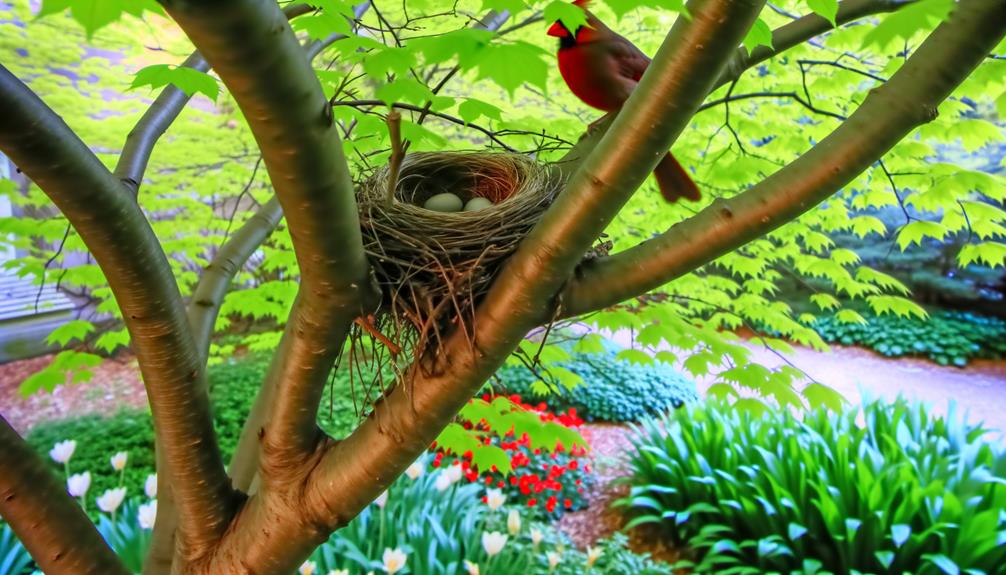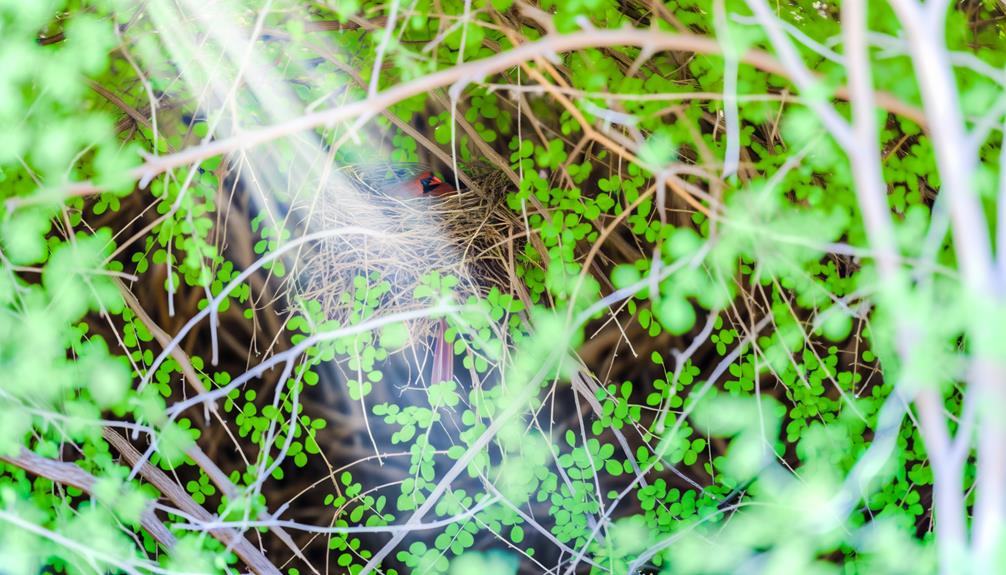Do Cardinals Leave Their Eggs Unattended and How Can You Ensure Their Safety?
Cardinals don't leave their eggs unattended often. The female typically handles incubation, ensuring the eggs stay at an ideal temperature.
Meanwhile, the male provides food and guards the nest. This vigilance reduces predation risks.
Nests are hidden and crafted from twigs, grasses, and bark, making them hard to spot. Their careful nest site selection and synchronized hatching of 3-4 eggs demonstrate their meticulous care.
Parental roles are essential for reproductive success and fledgling development, with both parents sharing duties. Urban development can affect nesting success and highlights the need for preserving natural habitats.
Explore deeper insights into their nesting behavior.

Key Takeaways
- Cardinals rarely leave their eggs unattended, ensuring constant protection and temperature regulation.
- The female primarily incubates the eggs, leaving briefly only for feeding and short breaks.
- The male provides food and guards the nest, allowing the female to minimize her absences.
- Both parents share vigilant nest guarding duties to deter predators effectively.
- Constant parental presence is crucial for maintaining ideal incubation conditions and protecting eggs from threats.
Cardinal Nesting Sites

Cardinals typically choose dense shrubs, small trees, or tangled vines as their preferred nesting sites to guarantee maximum protection and concealment for their eggs.
You can observe that they often pick locations that are well-hidden, ensuring predators find it difficult to spot their nests.
The ideal height for these nests is usually between 3 to 10 feet above ground level, which provides a strategic vantage point while still being accessible.
Cardinals use twigs, grasses, and bark to construct their nests, creating a sturdy yet camouflaged structure.
By selecting such intricate and concealed locations, cardinals maximize their chances of successfully raising their young.
This natural behavior underscores their instinctive drive for survival and protection in their environment.
Egg Laying Process
During the egg-laying process, female cardinals typically lay one egg per day until their clutch, usually consisting of three to four eggs, is complete. Each egg measures around 2.3 cm in length and is light green, speckled with brown spots. You'll find that the eggs are laid in a neat, cup-shaped nest constructed from twigs, grass, and leaves.
| Day | Description |
|---|---|
| Day 1 | First egg laid |
| Day 2 | Second egg laid |
| Day 3 | Third egg laid |
| Day 4 | Fourth egg laid (if any) |
The female cardinal's meticulous approach ensures that all eggs are at the same developmental stage. This synchronizes hatching, which is vital for the survival and care of the young birds.
Incubation Period

Once the clutch is complete, the female cardinal begins the incubation period, maintaining a consistent temperature to ensure proper development of the embryos. You'll notice she stays on the nest, ensuring the eggs are kept at around 100°F (37.8°C).
This incubation period typically lasts 11 to 13 days. During this time, she's very attentive, only leaving briefly for necessary activities like feeding and hydration. The embryo development depends heavily on this warmth, as it helps regulate cellular activity and growth.
The female's dedication to maintaining this precise temperature is essential because any significant deviation can lead to developmental issues or even egg failure. So, her role during incubation is crucial for the successful hatching of the chicks.
Male and Female Roles
The male and female cardinals exhibit distinct but complementary roles during the nesting period, ensuring the survival and well-being of their offspring. The male primarily focuses on feeding and protecting the female and the nest, while the female takes charge of incubating the eggs and caring for the nestlings. Both roles are critical for successful reproduction.
| Role | Responsibility |
|---|---|
| Male Cardinal | Feeding the female during incubation |
| Protecting the nest from predators | |
| Gathering food for the offspring | |
| Female Cardinal | Incubating the eggs |
| Caring for and feeding the nestlings post-hatch |
This division of labor allows each parent to specialize in tasks that maximize their offspring's chances of survival, illustrating an evolved partnership in the natural world.
Nest Guarding Behavior

You'll observe that cardinals exhibit specific patterns of parental vigilance to guarantee their eggs' safety. They employ various predator deterrence strategies, including aggressive displays and vocalizations.
Additionally, they shift nesting duties between the male and female to maintain constant protection.
Parental Vigilance Patterns
During the incubation period, cardinal parents exhibit a high degree of vigilance, often taking turns to ensure their eggs remain protected from potential predators. You'll observe that both the male and female share the responsibility of nest guarding. The female typically incubates the eggs, while the male stands sentinel nearby, ready to alert and defend.
This cooperative effort minimizes the time the nest is left unattended. They maintain a strict regimen, ensuring one is always close. Their keen senses and constant communication allow them to detect threats swiftly. Such behaviors are pivotal for the survival of their offspring, showcasing a remarkable level of parental investment and coordination.
This vigilance isn't just instinctual but a well-honed strategy for reproductive success.
Predator Deterrence Strategies
Cardinal parents employ a range of predator deterrence strategies, meticulously guarding their nests to ensure the safety of their eggs. You'll notice them using distraction displays, where they feign injury to lure predators away from the nest.
Their frequent, aggressive vocalizations serve as both warnings to potential threats and calls for assistance from their mate. Cardinals also choose nesting sites with dense foliage, providing natural camouflage and physical barriers against predators.
When you observe their behavior, you'll see how they adapt their vigilance based on the level of threat, increasing their defensive actions when necessary. This proactive nest guarding behavior is essential for the survival of their offspring, ensuring that the eggs are well-protected at all times.
Shifts in Nesting Duties
In their nesting duties, male and female cardinals take turns guarding the nest, making sure that one parent is always on alert while the other forages for food. This shift system maximizes the protection of their eggs and chicks.
You'll notice that the male often takes the day shift, standing vigil and fending off potential threats, while the female primarily incubates the eggs and takes the night shift. This division of labor guarantees continuous nest security and efficient resource gathering.
Each parent's role is crucial, as it balances the need for both sustenance and safety. The shared responsibility highlights their cooperative breeding strategy, which greatly enhances the survival rate of their offspring.
Feeding During Incubation
How do cardinals manage to feed themselves while guaranteeing their eggs remain protected and warm during incubation?
Cardinals exhibit a cooperative strategy where the male plays a pivotal role in feeding the incubating female. He forages for food and brings it back to her at the nest. This allows the female to maintain constant contact with the eggs, ensuring they stay warm and develop properly.
When the female needs to leave briefly, she does so during warmer parts of the day, reducing heat loss from the eggs.
This division of labor and strategic timing guarantee that the eggs remain safeguarded while both parents meet their nutritional needs.
Such behavior exemplifies the species' adaptive strategies to balance survival and reproductive success.
Predation Risks

Ensuring the eggs are constantly guarded and warm inevitably reduces the risk of predation, yet several threats still loom over a cardinal's nest. Predators like snakes, squirrels, and birds of prey are always on the hunt for unprotected nests. You'll notice that even a momentary lapse in vigilance can lead to disastrous outcomes, as these predators exploit any opportunity.
Cardinals often build their nests in dense shrubbery to minimize visibility, but this strategy isn't foolproof. You might find that larger predators can still penetrate these defenses. Additionally, human activity, such as landscaping or construction, can inadvertently expose nests, making them more vulnerable.
Understanding these risks underscores the importance of constant, careful monitoring by the parent birds.
Temperature Regulation
Cardinals actively maintain ideal temperatures for their eggs by frequently adjusting their position and using their bodies to provide necessary warmth.
You'll notice that the female cardinal stays on the nest most of the time, carefully regulating the heat. She uses her brood patch, a featherless area on her abdomen, to transfer prime heat directly to the eggs.
This active regulation is vital because egg temperatures need to remain within a narrow range for proper embryonic development. Should the ambient temperature drop or rise, the cardinal responds by either fluffing her feathers to trap warmth or slightly elevating her body to allow cooling.
Through these meticulous actions, cardinals optimize their eggs remain viable and ready to hatch.
Nest Camouflage

A cardinal's nest is cleverly camouflaged within dense foliage to protect its eggs from predators. You'll find these nests hidden among thick bushes, vines, or tree branches. This strategic placement reduces visibility and provides a natural shield against threats.
Here's how camouflage works:
- Natural Materials: Cardinals use twigs, leaves, and grasses that blend seamlessly with their surroundings.
- Optimal Positioning: Nests are often placed at heights that deter ground predators while remaining inconspicuous to aerial threats.
- Shade Utilization: Shade from leaves helps obscure the nest from sight.
- Proximity to Food: Nests are near food sources, reducing the need for extended absences.
- Dense Cover: Thick foliage offers robust protection against environmental elements and predators.
Human Interaction Effects
Human interaction with cardinal habitats can significantly impact the birds' nesting success and behavior. When you approach their nesting areas, cardinals may become stressed, leading to increased nest abandonment. Your presence can also attract predators, putting the eggs at greater risk. Maintaining a respectful distance and minimizing disturbances are essential for their well-being.
Additionally, urban development can reduce available nesting sites, forcing cardinals into suboptimal areas. By preserving native vegetation and avoiding unnecessary deforestation, you can support their natural habitat. Be mindful of using pesticides, as they can contaminate food sources and harm the birds.
Through conscious efforts, you can help maintain a balanced ecosystem, ensuring cardinals have a safe environment to nurture their young.
Fledgling Development

You'll notice that fledgling cardinals go through distinct growth stages, starting with hatching and ending in their ability to fly.
Throughout this period, parental feeding patterns are crucial in supplying the needed nutrients for growth.
Understanding both the timeline of these stages and the frequency of feedings is vital in grasping fledgling survival and growth.
Growth Stages Timeline
The growth stages of cardinal fledglings can be meticulously mapped from hatching to their eventual independence, revealing critical milestones in their development.
At hatching, fledglings are altricial, meaning they're born blind and featherless, requiring constant parental care. Within a week, their eyes open, and pin feathers start to emerge.
By the second week, they begin to grow more feathers and show increased mobility. Around day ten, they start to practice wing flapping, essential for future flight.
By two to three weeks, fledglings leave the nest, though they're not fully independent yet.
Post-fledging, they continue to develop gradually towards complete independence.
Parental Feeding Patterns
Throughout fledgling development, both cardinal parents actively partake in feeding their young to guarantee they receive the necessary nutrients for growth. You'll observe the male and female working in tandem, collecting insects and seeds. The male often takes the lead, ensuring the female can focus on brooding and protecting the nest. Each feeding session is crucial, as fledglings require frequent nourishment to sustain their rapid growth and development.
You'll notice that the parents employ a systematic approach, delivering food directly into the gaping mouths of their chicks. This precise feeding method ensures that each fledgling gets an adequate share.
As the fledglings mature, you'll see them gradually begin to self-feed, signaling their readiness to leave the nest.
Success Rate Factors
Several factors intricately influence the success rate of cardinal eggs, including predation, environmental conditions, and parental behavior. When you consider these variables, you'll understand their impact on egg survival rates.
Predation risk is a major factor, with many predators targeting unattended nests. Environmental conditions like temperature and humidity also play an essential role, affecting the egg's ability to develop.
- Predation: Unattended eggs are at higher risk from predators like snakes and birds.
- Temperature: Extreme temperatures can hinder embryonic development.
- Humidity: Inadequate humidity levels can desiccate eggs.
- Parental vigilance: Consistent parental presence can deter predators.
- Nest location: Strategic nest placement reduces exposure to threats.
Each of these factors is vital in determining whether cardinal eggs will hatch successfully.
Conclusion
In watching cardinals, you'll uncover the delicate dance of nature. Female cardinals, steadfast as sentinels, rarely leave their eggs unattended, ensuring their precious cargo's warmth and safety.
Males, ever vigilant, stand guard and bring food, embodying teamwork. Human interference, though well-meaning, can disrupt this symphony.
As fledglings spread their wings, you'll see the fruits of meticulous care. Remember, each cardinal nest is a tribute to resilience and nature's intricate balance.






